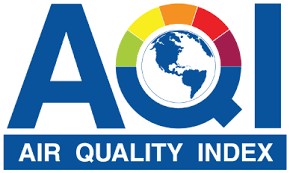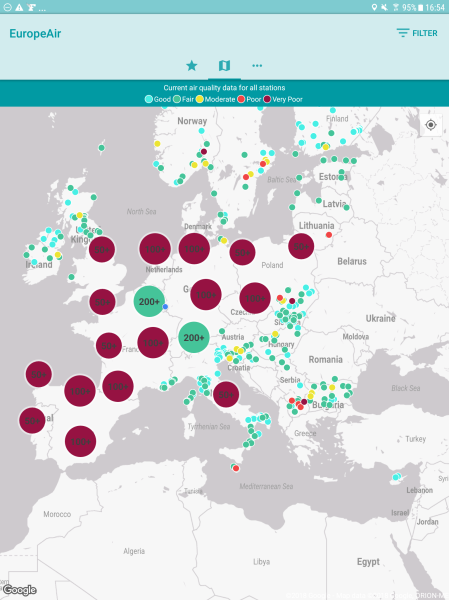 This is part 5 (the last part).
This is part 5 (the last part).
Click on the links below for the other parts.
8. The Luxembourg Meng Loft AQI (LuxAQI)
8.1. An introduction to the LuxAQI
The 7th May 2018 our minister of Environment presented a new app called “Meng Loft” (which means My Air) for smart-phones (IOS and Android). The app has been developed by the company 4sfera Innova (from Catalonia) together with the Environment Agency.
4sfera Innova specializes in air quality related software and created an Europe Air app in 2013 (it’s website seems to be dormant, the last update is from May2014).
The AQI for Luxembourg (let’s call it LuxAQI) is quite different from the EAQI: there are 10 quality levels from “Excellent” to “Miserable” (in French from “Excellent” to “Exécrable”) and also 10 color shadings.
The core pollutants used are O3, NO2 and PM10. Only 4 stations (2 in Luxembourg-City, Esch-Alzette and Beidweiler) measure PM10’s, so that for instance the whole Northern part of the country of Luxembourg has no PM sensor.
The app is nicely designed; the following picture is a screenshot from an Android tablet used at Bettendorf, 28 May, 17:34 local time (15:34 UTC):
The pointer “My location” shows that the LuxAQI has been computed for the region of Bettendorf; if one launches the app being outside of Luxembourg (or with locations services unavailable) the screen gives an average for the whole country (a nice feature!). Some other features of the app will be introduced later.
The next picture shows the naming of the quality bands and break-points used:
If I understand correctly, the 1h values are used for O3 and NO2, and 24h values for PM10’s. As with all other AQI’s seen, the sub-AQI with the highest index defines the Meng Loft LuxAQI.
My first reflection seeing this new app was “boy, 10 levels, 10 colors, is that not a bit too much?” Digging deeper I actually wonder why tiny Luxembourg has stubbornly ignored the harmonization efforts of Brussels EU Environmental Agency and has not simply chosen to use the EAQI. So we have here a situation which instead of clarifying will in my opinion add to the overall confusion. Is a deeper cause that 4sfera Innova had this app lying in a drawer and was good in salesmanship?
The next three pictures compare the LuxAQI with the corresponding EAQI for O3, NO2 and PM10. Note how clear and uncluttered the EAQI is w.r. to its new sibling!
Note that The EAQI “Moderate” category extends for all 3 pollutants over the LuxAQI “Très médiocre” which translate approximatively to “poor”!
The LuxAQI uses a “geostatistical” model to calculate the AQI from the surrounding readings up to a cell of 1km2 area. I could not find any further information on the model used, and I am highly suspicious on the ability to milk the PM10 data of the 4 stations to deliver a modelled value for any location in the Northern part of Luxembourg.
8.2. The problem with rural and city stations and the “highest index trumps all” strategy
In Luxembourg Vianden is the archetype of a rural station: the measuring station is not located in the small town of Vianden, but much higher up on the border of the basin of the SEO pumping storage facility. There is only minimal traffic, air is very pure (practically no NO2 and PM10) and solar UVB radiation is unfiltered by aerosols. As the region contains large forests (deciduous and not) there is during warm summer weather a healthy natural out-gasing of terpenes and isoprenes from the trees. Both volatile gases are O3 precursors. So it does not come as a surprise that “natural” O3 levels are high and do not diminish rapidly during nighttime due to the absence of O3 destroying NO. In Luxembourg-City the situation is exactly opposite: PM10 and NO2 levels a relatively high, O3 levels lower and fall off during nighttime in the absence of UVB but presence of O3 scavenging NO. The next 2 pictures show this for Vianden and Luxembourg Pl. Winston, a high traffic area:
At Vianden O3 values do not go lower at night than about 50 ug/m3 and than rise again, wheres at Pl. Winston the lower values of 30ug/m3 linger for a longer time. The usual pattern is normally much more smooth at Vianden than at Pl. Winston. (for a still clearer picture please look at the addendum).
But look carefully at the legends: Vianden’s air quality is POOR (index 7, deep orange) whereas that of Pl. Winston is relatively good (“assez bon”, light green).
Let’s take a look at the NO2 and PM10 situation for both stations. The next two pictures show the NO2 pattern:
 At Vianden No2 levels never exceed 10 ug/m3 whereas at Pl.Winston the oscillate around 45 ug/m3, with a peak value at least 6 times higher than that at Vianden.
At Vianden No2 levels never exceed 10 ug/m3 whereas at Pl.Winston the oscillate around 45 ug/m3, with a peak value at least 6 times higher than that at Vianden.
Now look at the daily PM10 levels for the last week:
The PM10 levels at Vianden are very low, never exceeding10ug/m3; at Pl. Winston they are constantly two to three times higher!
So let us summarize the situation:
Vianden LuxAQI= POOR
O3max = 150 NO2max < 10 PM10max < 7
PlaceWinston (Luxembourg-City) LuxAQI = Relatively GOOD
O3max = 60 NO2max = 60 PM10max = 22
The 2.5 times higher natural O3 levels put Vianden into the POOR category, whereas at Pl. Winston the much more dangerous and mostly anthropogenic PM10 and NO2 levels (3 and 6 times higher) are simply ignored and do not change the “relatively Good” classification!
Conclusion:
In my opinion the LuxAQI classification and break-point table introduced by “Meng Loft” is a bad choice: instead adopting a European standard, Luxembourg’s Environmental Agency has chosen for reasons unknown to go it’s own way, adding confusion to an already complicated matter. The Meng Loft app is visually satisfying and easy to use, but it suggests a precision that is more of a virtual character that of a physical reality.
9. Overall conclusion
The title of this 5 part comment was “air quality confusion”. I guess that the enumeration of the different AQI’s is a strong argument for the validity of the “confusion” qualifier. What all AQI’s wrongly point at is that a complicated situation can be well defined by a single number. The AQI’s suggests a scientific precision that is and can not exist. Increasing the number of the different levels as does the LuxAQI is simply an exercise in futility which adds to the confusion.
All AQI’s take the highest sub-index as the relevant parameter to define the air quality of the moment. I am not comfortable with that choice (even if everybody seems to accept) as it leads to a mis-qualification of clean air when natural O3 levels are higher.
(end of the 5th and last part).
Addendum 1:
A much clearer picture showing the different O3 pattern for rural Vianden (i.e. Mont Saint-Nicolas) and the urban traffic location at Luxembourg-Bonnevoie is given below (screenshots taken the 30May2018, 15:35 local time): the nightly minimum at Vianden is about 60 ug/m3, whereas it is lower than 10 ug/m3 at Bonnevoie.


Addendum 2:
4sfera Innova also has its own app called EuropeAir (Android version checked) which is easy to use and gives the standard EAQI . Here a screen-shot of today (30May2018); zooming in gives all the stations and the actual measurement data, but no time-graph of past values. The filter allows to select one pollutant (e.g. O3) only.











May 29, 2018 at 13:24 |
[…] Part 1, 2, 4, 5. […]
May 29, 2018 at 13:25 |
[…] Part 1, 3, 4, 5. […]
May 29, 2018 at 13:26 |
[…] This is part 1. Click on the links below for the other parts. Part 2, 3, 4, 5. […]
May 29, 2018 at 14:00 |
[…] on climate, global change and climate measurements « AQI: air quality confusion (3) AQI: air quality confusion (5, last part) […]
March 10, 2019 at 05:41 |
Great blog you have here but I was curious about if you knew of
any community forums that cover the same topics discussed here?
I’d really like to be a part of group where I
can get suggestions from other experienced individuals that share the same interest.
If you have any suggestions, please let me know. Many thanks!